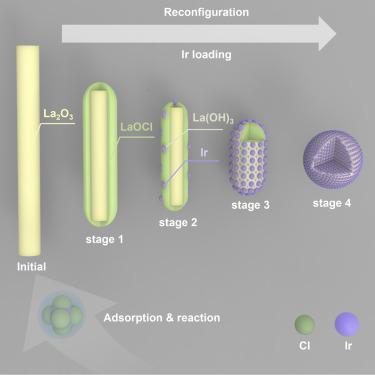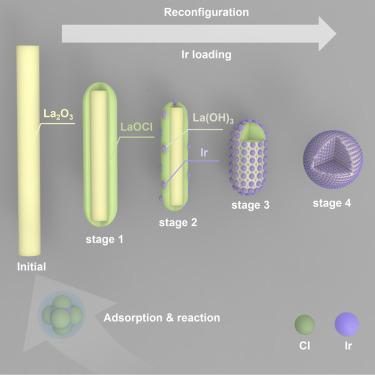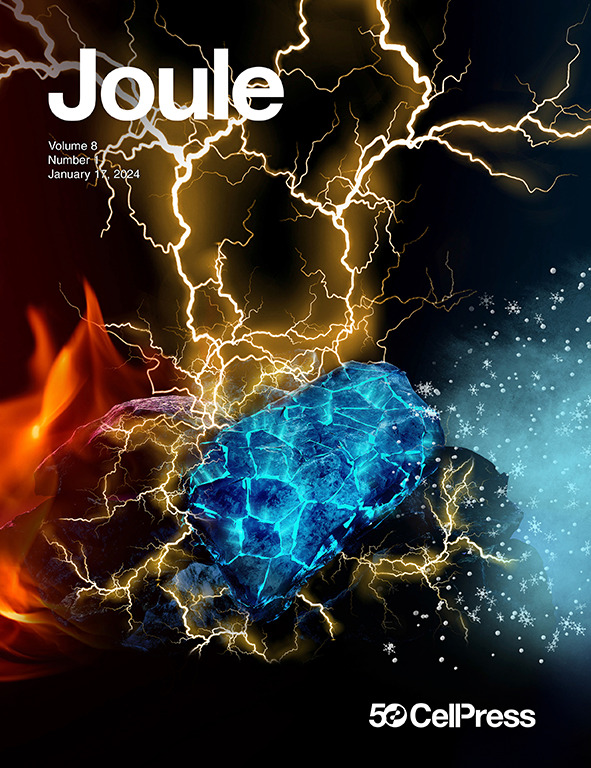动态模板重建诱导高电流密度PEMWE介孔铱催化剂
IF 35.4
1区 材料科学
Q1 CHEMISTRY, PHYSICAL
引用次数: 0
摘要
提高电流密度是降低水电解绿色制氢成本和提高效率的关键策略。然而,在高电流密度下的质量扩散和质子输运限制仍然是严重的障碍。在此,我们提出了一种新的策略来构建三维介孔IrO2骨架结构,以解决这些限制。利用La2O3模板重构过程中Ir纳米颗粒的动态加载,实现了超小Ir纳米颗粒在La2O3模板中的高密度嵌入。在电化学过程中,Ir纳米颗粒的原位氧化结合模板浸出导致三维介孔IrO2结构的形成。该催化剂可使质子交换膜电解(PEMWE)在5 a cm−2的电流密度下稳定运行2700小时以上,电压降解率为0.38 μV h−1,满足2030年欧盟清洁氢JU目标和2026年美国能源部(DOE)目标。本文章由计算机程序翻译,如有差异,请以英文原文为准。


Dynamic template reconstruction induced mesoporous iridium catalysts for high-current-density PEMWE
Enhancing current density is a crucial strategy for reducing costs and improving the efficiency of green hydrogen production through water electrolysis. However, mass diffusion and proton transport limitations under high-current densities remain serious obstacles. Here, we proposed a novel strategy to construct a three-dimensional mesoporous skeleton structure of IrO2 to address the limitations. By utilizing the dynamic loading of Ir nanoparticles during the La2O3 template reconstruction process, high-density embedding of ultra-small Ir nanoparticles in the template is achieved. During the electrochemical process, in situ oxidation of Ir nanoparticles combined with template leaching results in the formation of a three-dimensional, mesoporous IrO2 structure. The developed catalyst enables proton exchange membrane water electrolysis (PEMWE) to achieve stable operation for over 2,700 h at a current density of 5 A cm−2 with a voltage degradation rate of ∼0.38 μV h−1, which meets the 2030 EU Clean Hydrogen JU target and 2026 US Department of Energy (DOE) target.
求助全文
通过发布文献求助,成功后即可免费获取论文全文。
去求助
来源期刊

Joule
Energy-General Energy
CiteScore
53.10
自引率
2.00%
发文量
198
期刊介绍:
Joule is a sister journal to Cell that focuses on research, analysis, and ideas related to sustainable energy. It aims to address the global challenge of the need for more sustainable energy solutions. Joule is a forward-looking journal that bridges disciplines and scales of energy research. It connects researchers and analysts working on scientific, technical, economic, policy, and social challenges related to sustainable energy. The journal covers a wide range of energy research, from fundamental laboratory studies on energy conversion and storage to global-level analysis. Joule aims to highlight and amplify the implications, challenges, and opportunities of novel energy research for different groups in the field.
 求助内容:
求助内容: 应助结果提醒方式:
应助结果提醒方式:


